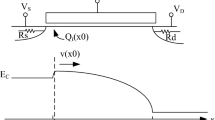Abstract
Progress in the technology of submicron semiconductor device, which makes a short-channel and quantum effects, having equations of nonlinear modelling, leads to complicated and time-consuming calculations. In order to control these complexities and obtain the device characteristics according to device parameters, a faster method is needed. In this paper, a combinational algorithm is proposed for modelling a nano silicon-on-insulator metal–oxide–semiconductor field effect transistor (SOI MOSFET) characteristic. The proposed method shows the same device characteristics with lower input parameters. In this method, a combination of genetic algorithm (GA) and artificial neural network are used. Then quantum evolutionary algorithm (QEA) is employed instead of genetic algorithm (GA) for comparing and modifying algorithm. Results show that the algorithm’s accuracy is 95% and 98% for test data of GA and QGA, respectively. Moreover, the reduction percentage of input parameters are 11% and 52% for GA and QEA, respectively. The simulation results represent that the implemented quantum genetic algorithm for prediction of device characteristics is more effective and accurate than GA.







Similar content being viewed by others
References
Colinge, J.P.: Silicon-on-insulator technology: materials to VLSI: materials to Vlsi. Springer, New York (2004)
Orouji, A.A., Anvarifard, M.K.: Novel reduced body charge technique in reliable nanoscale SOI MOSFETs for suppressing the kink effect. Superlattices Microstruct. 72, 111–125 (2014)
Ramezani, Z., Orouji, A.A.: A silicon-on-insulator metal–semiconductor field-effect transistor with an L-shaped buried oxide for high output-power density. Mater. Sci. Semicond. Process. 19, 124–129 (2014)
Plößl, A., Kräuter, G.: Silicon-on-insulator: materials aspects and applications. Solid State Electron. 44(5), 775–782 (2000)
Plouchart, J.O.: Applications of SOI technologies to communication. In: Compound Semiconductor Integrated Circuit Symposium (Csics), 2011 IEEE. pp. 1–4 (2011)
Cheng, Y., Hu, C.: MOSFET modeling & BSIM3 user’s guide. Springer, New York (1999)
Sánchez, F.G., Ortiz-Conde, A., Cerdeira, A., Estrada, M., Flandre, D., Liou, J.J.: A method to extract mobility degradation and total series resistance of fully-depleted SOI MOSFETs. IEEE Trans. Electron Devices 49(1), 82–88 (2002)
Lou, C.-L., Chim, W.-K., Chan, D.-H., Pan, T.: A novel single-device DC method for extraction of the effective mobility and source-drain resistances of fresh and hot-carrier degraded drain-engineered MOSFET’s. IEEE Trans. Electron Devices 45(6), 1317–1323 (1998)
Keser, M., Joardar, K., Motorola, M.: Genetic algorithm based MOSFET model parameter extraction. In: Technical Proceedings of the International Conference on Modeling and Simulation of Microsystems, pp. 341–344 (2000)
Xiao, Y., Trefzer, M.A., Walker, J.A., Bale, S.J., Tyrrell, A.M.: Two step evolution strategy for device motif BSIM model parameter extraction. In: Proceedings of 2014 IEEE Congress on Evolutionary Computation (CEC), pp. 2877–2884 (2014)
Ruizhen, L., Duoli, L., Du Huan, H.C., Zhengsheng, H.: SOI MOSFET model parameter extraction via a compound genetic algorithm. Chin. J. Semicond. 27(5), 796–803 (2006)
Ruizhen, L., Zhengsheng, H.: Model parameters extraction of a BSIM SOI model based on the genetic algorithm. Chin. J. Semicond. 26(8), 1676 (2005)
Hayati, M., Akhlaghi, B.: An extraction technique for small signal intrinsic parameters of HEMTs based on artificial neural networks. AEU Int. J. Electron. Commun. 67(2), 123–129 (2013)
Holland, J.H.: Adaptations in natural and artificial systems. MIT press, Cambridge (1975)
Goldberg, D.E.: Genetic algorithms in search, optimization and machine learning, p. 372. Addison-Wesley Longman Publishing Co.,Inc., Boston (1989)
Mitchell, M.: An introduction to genetic algorithms. The MIT Press, Cambridge (1999)
Yuan, X., Elhoseny, M., El-Minir, H.K., Riad, A.M.: A genetic algorithm-based, dynamic clustering method towards improved WSN longevity. J. Netw. Syst. Manage. 25(1), 21–46 (2017)
Elhoseny, M., Yuan, X., Yu, Z., Mao, C., El-Minir, H.K., Riad, A.M.: Balancing energy consumption in heterogeneous wireless sensor networks using genetic algorithm. IEEE Commun. Lett. 19(12), 2194–2197 (2015)
Elhoseny, M., Shehab, A., Yuan, X.: Optimizing robot path in dynamic environments using genetic algorithm and bezier curve. J. Intell. Fuzzy Syst. 33(4), 2305–2316 (2017)
Yuan, X., Zhang, J., Buckles, B.P.: Evolution strategies based image registration via feature matching. Inf. Fusion 5(4), 269–282 (2004)
Han, K.-H., Kim, J.-H.: Quantum-inspired evolutionary algorithm for a class of combinatorial optimization. IEEE Trans. Evol. Comput. 6(6), 580–593 (2002)
Hey, T.: Quantum computing: an introduction. Comput. Control Eng. J. 10(3), 105–112 (1999)
Jang, J.S.R., Sun, C.T., Mizutani, E.: Neuro-fuzzy and soft computing; a computational approach to learning and machine intelligence. IEEE Trans. Automat. Contr. 42(10), 1482–1484 (1997)
Himmel, C.D., May, G.S.: Advantages of plasma etch modeling using neural networks over statistical techniques. IEEE Trans. Semicond. Manuf. 6(2), 103–111 (1993)
Huang, Y., Edgar, T.F., Himmelblau, D.M., Trachtenberg, I.: Constructing a reliable neural network model for a plasma etching process using limited experimental data. IEEE Trans. Semicond. Manuf. 7(3), 333–344 (1994)
Mocella, M.T., Bondur, J.A., Turner, T.R.: Etch process characterization using neural network methodology: a case study. In: International conference on Process Module Metrology, Control and Clustering. International Society for Optics and Photonics, pp. 232–242 (1992)
Bose C.B., Lord, H.A.: Neural network models in wafer fabrication. In: International Conference on Optical Engineering and Photonics in Aerospace Sensing. International Society for Optics and Photonics, pp. 521–530 (1993)
Rietman, E., Lory, E.R.: Use of neural networks in modeling semiconductor manufacturing processes: an example for plasma etch modeling. IEEE Trans. Semicond. Manuf. 6(4), 343–347 (1993)
Manual, A.U.S.: 3-D device simulator. Silvaco Inc., Santa Clara (2012)
Jagadesh Kumar, M., Orouji, A.A.: Investigation of a new modified source/drain for diminished self-heating effects in nanoscale MOSFETs using computer simulation. Physica E 33(1), 134–138 (2006)
Ramezani, Z., Orouji, A.A.: Investigation of veritcal graded channel doping in nanoscale fully-depleted SOI-MOSFET. Superlattices Microstruct. 98, 359–370 (2016)
Author information
Authors and Affiliations
Corresponding author
Rights and permissions
About this article
Cite this article
Sarvaghad-Moghaddam, M., Orouji, A.A., Ramezani, Z. et al. Modelling the spice parameters of SOI MOSFET using a combinational algorithm. Cluster Comput 22 (Suppl 2), 4683–4692 (2019). https://doi.org/10.1007/s10586-018-2289-6
Received:
Revised:
Accepted:
Published:
Issue Date:
DOI: https://doi.org/10.1007/s10586-018-2289-6




